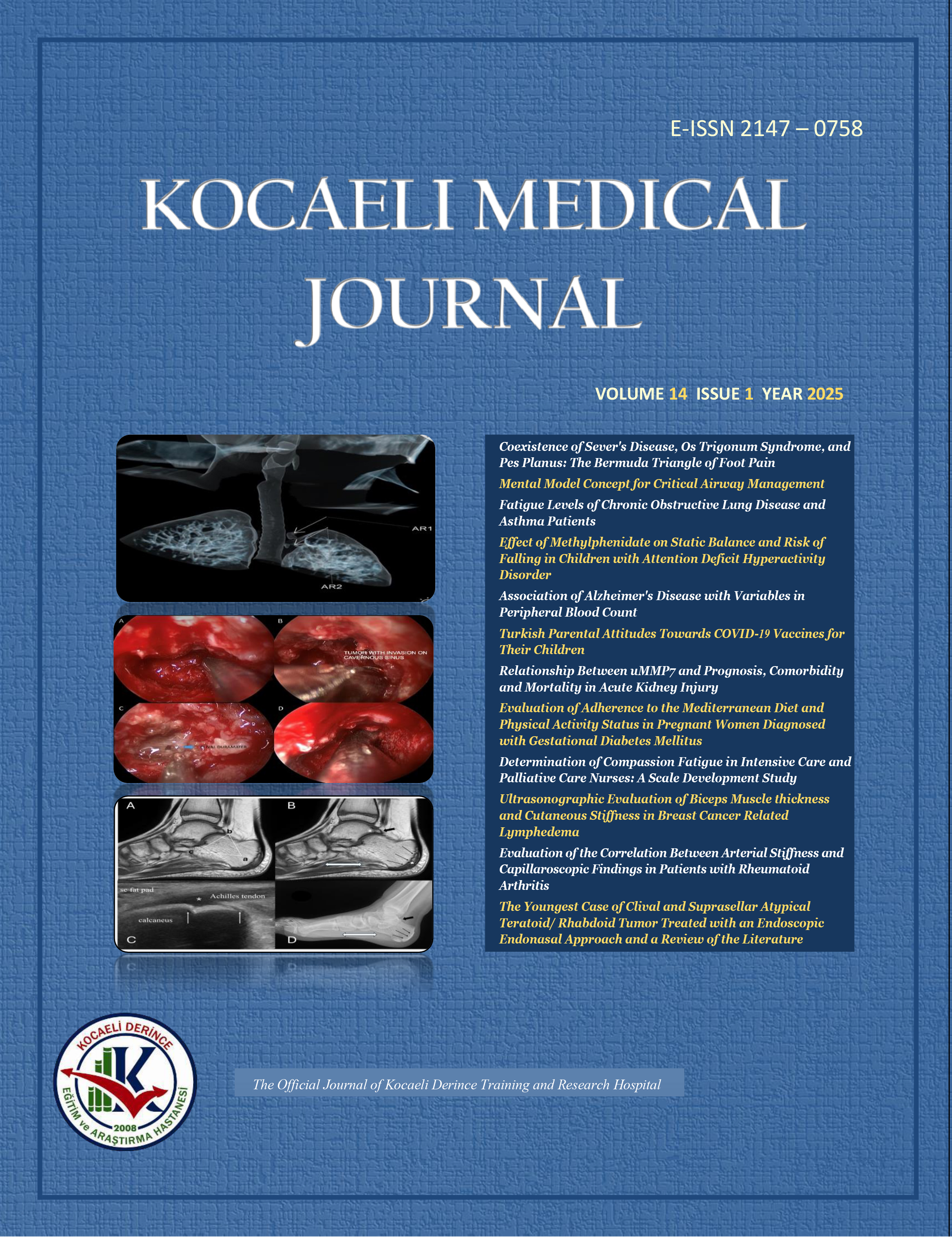
Volume: 3 Issue: 2 - 2014
| ORIGINAL ARTICLE | |
| 1. | Our Experience İn Percutaneous Tracheostomy Which Performed By GRIGGS Method: 38 Cases Sema Öncül, Mehmet Yılmaz, Elif Atar Gaygusuz, Duygu Akalın Oysu, Osman Esen, Tahsin Şimşek, Mehmet Hamdi Aytekin, Hilal Doğan Alcal, Başol Bay Pages 1 - 4 OBJECTIVE: In this study we aimed to present our percutaneous dilatational tracheostomy (PDT) practices by using Griggs technique in our intensive care unit. METHODS: The data of 38 patients who were performed PDT by using Griggs tecnique were analyzed retrospectively. Demographic data of patients, mechanic ventilation time, the procedure time, the early complications (minor bleeding, surgical bleeding, subcutaneous emphysema, pneumothorax, false passage, hypoxia and mortality), diagnosis of patients, intensive care unit stay time and the patient status at the hospital discharge were recorded. RESULTS: The mean procedure time was 10.26±3.7 min. The early complications of the procedure were found as a minor bleeding in two patients (%5.2), surgical bleeding in one patient (%2.6) and arrhythmia in one patient (%2.6). CONCLUSION: PDT has a low complication rate and can be applied safely in intensive care unit bedside practice. |
| 2. | Vitamin D status in symptomatic knee osteoarthritis: Association with clinical and radiographical parameters Tuba Guler, Yeşim Garip, Pelin Yıldırım, Rabia Terzi Pages 5 - 10 OBJECTIVE: We aimed to examine the relationship between vitamin D deficiency and knee osteoarthritis in women aged 45-60. METHODS: 110 female patients with knee osteoarthritis were included. Patients were divided into two groups according to vitamin D level: group 1 included 65 patients with low vitamin D (< 20 ng/ml), and group 2 included 45 patients with vitamin D in normal ranges (≥20 ng/ml). Severity of osteoarthritis was evaluated by Kellgren-Lawrence (KL). Pain, stiffness and functional status were measured by Western Ontario and McMasters Universities Osteoarthritis Index (WOMAC). RESULTS: Rate of vitamin D deficiency was 59.09%. Mean vitamin D level was 9.09±3.82 in group 1 and 27.84±6.42 in group 2. Vitamin D was significantly lower in group 1 (p=0.00). K/L grade 1(28.89%) and 2(64.44%) were most frequently found in group 2, whereas grade 3(38.46%) and 4(15.38%) were found in group 1. Group1 had significantly higher radiographic grades than group 2 (p=0.00). Patients in group 1 scored significantly higher in WOMAC (p=0.00). K/L scores were correlated with VAS-pain and WOMAC scores (p=0.00). K/L scores showed no significant correlation with body mass index (BMI) (p=0.82). CONCLUSION: Vitamin D deficiency is associated with knee OA in terms of pain, stiffness, functional and radiological status. |
| 3. | Alterations Of Pulmonary Functions Occuring After Mitral Valve Replacement In Long-Term Follow-Up Hakan Parlar, Özgür Barış, Ersan Özbudak, Şadan Yavuz, Muhip Kanko, Kamil Turan Berki Pages 11 - 15 OBJECTIVE: In this study, we aimed to evaluate the reversibility of the alterations of pulmonary functions in the group of patients who underwent mitral valve surgery due to mitral valve disease. METHODS: In this study, 26 of patients were evaluated who underwent mitral valve replacement in our clinic between January 2008 and June 2011. The patients with aortic regurgitation, coronary artery disease, chronical obstructive lung disease were excluded. Patients demographic characteristics, echocardiographical findings and spirometrical pulmonary function test results were recorded. SPSS (statistical package for social sciences) for Windows 10.0 programme was used for statistical analysis. RESULTS: Study group of patients were evaluated retrospectively. FVC, FEV1, FEV1/FVC, FEF 25-75 %, PEF values were compared pre and postoperatively. We considered p<0,001 as statistically significant. All measures we evaluated were statistically significant. CONCLUSION: We concluded that the important part of the pulmonary dysfunctions due to mitral valve disease are reversible. |
| 4. | Endoscopic examination results in patients with iron deficiency anemia Selçuk Yaylacı, Ahmet Bilal Genç, Ali Tamer, Hakan Cinemre, Mustafa İhsan Uslan Pages 16 - 19 OBJECTIVE: Gastrointestinal system diseases are one of the most significant cause of iron deficiency. Aim of this research is to define gastrointestinal endoscopy findings on iron deficiency anemia patients. METHODS: At the internal medicine clinic of Sakarya University hospital; iron deficiency anemia patients retrospectively evaluated. Patients demographic data, upper and lower endoscopic findings and if available biopsy results have been recorded. All of data statistically analyzed. RESULTS: 133 patients (67 men, 66 women) of iron deficiency anemia participated to our research. Average age was 63,8±17. Upper gastrointestinal endoscopy has been done to 129 (96.9%) patients and lower gastrointestinal endoscopy has been done to 63 (47.3%) patients. 26.3% of patients that upper gastrointestinal endoscopy applied, rated as normal. 6.9% of patients diagnosed with cancer and 10% of patients diagnosed with gastric ulcer. All gastric cancer patients and a gastric ulcer patient who endoscopic diagnosed was reported patologicaly as adenocarsinom. 57.1% of patients that lower gastrointestinal endoscopy applied, resulted as no traces of patalogy. Beside of this, 6.3% diagnosed with colon canser, 3.1% diagnosed with rectum canser. Upper and lower gastrointestinal system endoscopy were done together to 59 (44,3%) patients. Any pathology wasnt traced on %18,6 of the patients who the both procedure were done. CONCLUSION: Iron deficiency is substantial symptom of gastrointestinal tract disease. Upper and lower gastrointestinal endoscopy is essential for research and diagnose of those patients. |
| CASE REPORT | |
| 5. | Subclavian Artery Thrombosis Özgür Dikme, Özlem Dikme, Hakan Topaçoğlu Pages 20 - 23 Introduction: Subclavian artery thrombosis is a condition in which the blood flow through the vessel is suddenly obstructed. Thrombosis may be acute or chronic. The incidence of subcla¬vian stenosis in the general population ranges from 3% to 4%. Atherosclerosis is the most common cause of this condition. Few practitioners consider the importance of upper extremity arterial disease; which, besides causing hand and arm symptoms, can be associated with significant neurologic and cardiac sequelae. Case Report: We describe a 64 year old male patient who admitted emergency department while he couldn't measure blood pressure from the left arm. Subclavian artery thrombosis was diagnosed and he was treated with thrombectomy. Conclusion: In the emergency department, light-headedness, vertigo, syncope, ataxia, nausea, arm pain and weakness, coldness or loss of sensation in the arm for all patients with subclavian artery thrombosis should be considered in the differential diagnosis. |
| 6. | Dyke-Davidoff-Masson Syndrome: A Case Report Mehtap Çavuşoğlu, Semra Duran, Eda Elverici, Enis Yüksel Pages 24 - 26 Dyke-Davidoff-Masson syndrome is characterized with drug resistant epileptic seizures, cerebral hemiatrophy, facial asymmetry, contralateral hemiplegia or hemiparesis, mental retardation, unilateral thickening of the skull, extensive widening of paranasal sinuses and increase in air levels. The syndrome was first described in 1933 by Dyke et al. and both congenital and acquired factors are involved in the etiology. In this case report, we aimed to present the diagnostic magnetic resonance imaging findings of a 36-year-old mentally retarded female patient with Dyke-Davidoff-Masson syndrome. |
| REVIEW ARTICLE | |
| 7. | Pediatric Voice Disorders and The Effectiveness Of Voice Therapy Elçin Tadihan Özkan, Erhan Demirhan Pages 27 - 33 Voice disorders induced by many different causes can lead to communication disorders. Communication disorders in childhood can affect the social, academic and personal development of the children in a negative manner. For this reason, the most effective treatment of voice disorders in childhood is extremely important. Surgical intervention is not a common treatment in childhood voice disorders but voice therapy is an extremely effective treatment method. |
| 8. | Early Brain Injury After Subarachnoidal Hemorrhage Murat Ulutaş, Haydar Sekmen, Mehmet Seçer, Soner Şahin Pages 34 - 42 Subarachnoidal hemorrhage is one of the most important causes of mortality and morbidity among the worlds population. Management of late complications (including rebleeding, hydrocephaly, late ischemic neurological deficit, or electrolyte imbalance) can improve outcomes. However, pathophysiological processes, such as deterioration of cerebral hemodynamics, development of vascular-neuronal apoptosis, and genetic factors that occur with the hemorrhage, lead to early brain injury that cannot be prevented. In this review, the significance of the cerebral blood flow after subarachnoidal hemorrhage and pathophysiological mechanisms that lead to early brain injury are summarized. |
| LETTER TO THE EDITOR | |
| 9. | Editöre mektup: Kronik böbrek hastalarında ortalama trombosit hacmi ölçümü standardizasyona ihtiyaç gösterir Cengiz Beyan, Esin BeyanPages 43 - 44 Abstract | |












